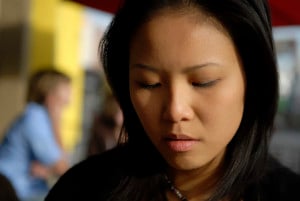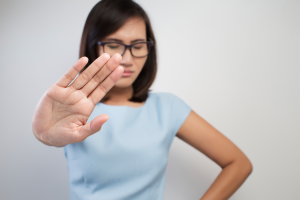Being bisexual and polyamorous means that I go double-or-nothing on most of the stereotypes and misconceptions.
People have two reasons to assume I’m sexually insatiable or unable to commit. It’s annoying, but at least when they hear that I’m bi and assume I’m non-monogamous, or hear that I’m polyamorous and assume I’m bi, they’re not wrong.
Bisexuality and polyamory play so nicely together as identities that many people assume bi erasure isn’t a problem for polyamorous bisexuals. And in some ways, they’re right. When I read an article about bi erasure, a whole lot of it is foreign to my experience. In my polyamorous bubble, nobody argues that my orientation isn’t real or that I have to pick a side. And that’s great.
However, bi erasure does operate in more subtle ways, at least in the straight-ish polyamorous communities that I’ve spent the most time in.
What Do I Mean By ‘Straight-ish’ Polyamory?
Many polyamorous communities are predominantly queer, with a broad spectrum of genders and orientations represented. Most of what I’m going to say below doesn’t necessarily apply to those communities.
The communities I’m talking about are those where most of the people involved are binary-identified and the majority of relationships are heterosexual.
There are a lot of primary couples or larger domestic units that center around connections between men and women. If you happened upon a meet-up of straight-ish polyamorous people, you probably wouldn’t be able to guess right away that they were a sexual minority group.
By that definition, the straight-ish polyamorous community is still pretty huge and diverse. In this article, I’m drawing from my own observations of local communities I’ve been a part of, as well as conferences and online writings. I’m going to make quite a few generalizations based on those experiences, and I guarantee you I’ll say some things that aren’t true for the polyamorous communities near you.
I’m more interested in raising awareness and starting conversations than telling people how it is. So if some things in this article don’t apply to you or the polyamorous people you know, cool! I bet some of them do, though.
So here are some of the ways that I’ve observed bi erasure in straight-ish polyamorous communities. Because I want to talk about how this shows up – and how we can do better.
1. Heteroflexibility and Bisexuality Are Conflated
In the straight-ish polyamorous world, bisexuality for women is almost the norm. In some communities, it’s the default assumption. I’ve found myself learning with surprise that a woman I’d just met was straight, not bi.
Most people won’t bat an eye if a woman who came to a polyamory meet-up with a male partner flirts with another woman. Nobody will be confused about whether she’s gay or straight; no one will question if she’s pretending or going through a phase.
However, there can be a fuzzy line between “I’m intimate with women because we share a partner and I’m comfortable with that” and “I’m intimate with women because I’m sexually and romantically interested in women.”
I’ve shared beds with quite a few women, most of whom I wasn’t dating and many of whom were straight, because my partners were dating them and wanted to get to sleep with both of us. That’s not a problem for me, although the double standard is irritating – none of my male partners have been comfortable sharing a bed with each other. (I know plenty of polyamorous men do share beds with male metamours, but I also know that my experience is not uncommon.)
Similarly, many polyamorous women I know are comfortable with and even enjoy group sex involving other women, even if they aren’t interested in dating women separately.
There’s nothing wrong with straight women being comfortable with intimacy with other women. The problem is that women’s bisexuality can unconsciously get absorbed into the larger pool of women’s heteroflexibility (I’m using that word for convenience – just because someone fits the above description doesn’t mean they identify as heteroflexible).
People may assume that a polyamorous woman’s interest in women is more casual or only in the context of group sex or group relationships.
I want to be careful here not to sound like I’m policing anyone’s identity. You don’t have to be equally interested in men and women to identify as bisexual. If you primarily date men, but enjoy being intimate with women in group situations, you can still be bisexual.
What I’m saying is that, because of how common heteroflexibility and casual bisexuality are, people can hear, “I’m a bisexual polyamorous woman” and still not take that to mean “I want to have serious, independent relationships with women (and/or non-binary and agender folks).”
And in that respect, I can feel almost as invisible as I do in the monogamous world.
2. Women’s Relationships with Women Still Get Sidelined
If a polyamorous woman walks into a room with a man and a woman that she’s dating, guess which one most people will assume is her primary partner?
The pattern of “bisexual woman has a primary male partner and other partners who may be women or men” is so common in our narratives of polyamory that people will tend to assume that structure is in play.
A bisexual woman who has one or two primary-level girlfriends, and dates a man more casually? That’s much less common.
Polynormativity is a word that writer Andrea Zanin coined to describe the version of polyamory that looks as much as possible like heterosexual monogamy. While a lot of polynormativity is about rules and relationship structures, some of it is about heterosexuality – specifically, viewing heterosexual relationships as more “real” or significant than queer ones.
We can slip into polynormativity subconsciously. None of my friends in the straight-ish polyamorous world believe that heterosexual relationships are better than queer ones. If they did, we wouldn’t still be friends!
But when all the long-term relationships you see are heterosexual and domestic, and all the same-gender relationships are shorter-lived and less entangled, it’s hard not to view that as the “norm.” Sometimes you might subconsciously reinforce that structure in your life and in the lives of your friends.
Women’s relationships with women can get sidelined even when everybody involved wants to honor them. Often, we have binary gender norms to thank for that.
When I was dating two different men and one woman, my girlfriend and I had regular dates with our male partners, but only rarely made time for the two of us to be alone together. We were both strongly conditioned to avoid being “selfish,” which meant that we prioritized the wishes that other people expressed rather than expressing our own. This meant I often went on more dates with the men in the polycule than with my girlfriend.
3. Bi Men Are as Invisible as Ever
You might notice that so far we’ve been talking exclusively about bisexual women. Don’t worry, bi men, I haven’t forgotten you! It’s just that—well—the rest of the straight-ish polyamorous world kinda has.
While bisexuality is common enough to be the default assumption for women, most people assume that a polyamorous man who dates women is only interested in women.
For fun, I just asked my partner how many bi men he knew in our local polyamorous community. He came up with one, maybe two. I could only name one for sure, with two maybes. Interestingly, there was no overlap in the people we named – each of us knew because of private conversations, not because the men openly proclaimed their bi identity.
This speaks to the level of stigma that still exists around men’s bisexuality.
Even in a group that’s very accepting of sexual diversity in theory, in practice, it’s still a little risky for a man to come out as being interested in other men. In US culture, even wonderful, progressive, queer-rights-supporting men have trouble finding and uprooting all the seeds of homophobia that their society has planted in them.
How Can I Fix This in My Polyamorous Community?
1. Don’t Assume
Until they’ve told you, you don’t know whether that person you’ve just met is gay, straight, bi, pan, or something else. That’s true even if you’ve met one or more of their partners.
When polyamory and sexual fluidity mix, someone can have a long-time partner from when they identified one way, but now be only interested in dating people of a different gender. People also have outliers, where they are almost exclusively attracted to one gender, but there’s that one exception!
And of course, they could be asexual or demisexual, or mostly interested in romance with one gender but sex with another. The possibilities are endless!
So when you meet someone new, abandon all assumptions about their sexual orientation or gender identity, even if those things seem obvious on the surface. Wait to find out.
2. Take Same-Gender Relationships Seriously
Be aware that you probably have an inner bias that says a person’s same-gender relationships are less important than their hetero relationships. I have it, too!
Being influenced by our culture doesn’t make us bad people – but now that we’re aware of it, we can try to counteract it.
So notice the ways in which you might be unconsciously giving precedence to heterosexual relationships – whether in your own life, or your partners’ or friends’ lives. When you catch yourself assuming that a hetero relationship might turn into a long-term domestic partnership, while a queer relationship wouldn’t, turn that assumption on its head.
Especially for men who are dating bisexual women: Make sure you’re giving your partners’ relationships with women enough space to blossom. Check in and see if they’re getting as much time with their girlfriends as they want. Give them privacy.
3. Expand Your Comfort Zone
If most of your circle is straight and cisgender, you probably have some areas of discomfort or lack of awareness about other gender and sexual minorities.
Straight-ish polyamorous people live in a weird zone of being a sexual minority, but often having more in common with the straight world than the queer world. So when someone in your circle suddenly brings around a non-binary partner who uses “they” pronouns, or a man you always assumed was straight suddenly forms a primary-level relationship with another man, it might throw you a little.
Being inclusive and accepting is about more than just “tolerating” different identities. It takes practice and knowledge to know how to treat people in ways that make them feel respected and affirmed.
So this is a good time to take inventory of how comfortable and knowledgeable you are with different gender and sexual minorities, and read up on the ones you’re less in touch with. (Browsing our LGBTQIA+ archives might be a good place to start!)
That way, you’ll be prepared to be a better ally and friend to queer people in your poly circle, whether they’re new additions, or people you already know!
Even in a community that’s more accepting than most, bisexual people can feel sidelined and invisible. It’s okay to speak up when you feel that your identity is being erased, even if it looks very different from the way monogamous bisexual folks experience erasure.
Recognizing the way multiple identities affect each other is a key piece of intersectional feminism.
By identifying these patterns and working to change them, we make our communities stronger, more supportive, and more feminist.
[do_widget id=’text-101′]
Ginny Brown is a Contributing Writer for Everyday Feminism, as well as a speaker and educator specializing in sexuality and relationships. She writes for various publications and has her own blog here. She lives in the Philadelphia area with her poly family and three cats. Follow her on Twitter @lirelyn.
Search our 3000+ articles!
Read our articles about:
Our online racial justice training
Used by hundreds of universities, non-profits, and businesses.
Click to learn more





















